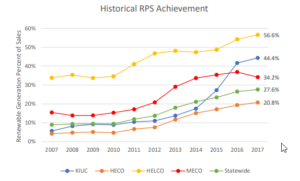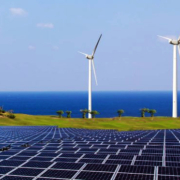Energy Reforms; Essential to Hawaii’s Decarbonization Goals
Key to Climate mitigation measures are the state’s on-going and overdue transition to clean, renewable, and self-sufficient energy generation. BeyondKona has reported extensively on the energy and its linkage to all aspects of life in Hawaii. Designed to power Hawaii’s economy, transportation, and telecommunications infrastructures, this statewide energy transition is essential on Hawaii’s path to sustainability.
Key Energy Facts for the State
- Hawaii was the first state to set a deadline for generating 100% of its electricity from renewable energy sources, which is required to be achieved by 2045.
- Despite being among the five states with the lowest total energy consumption, Hawaii uses about 11 times more energy than it produces. More than four-fifths of Hawaii’s energy consumption is petroleum, making it the most petroleum-dependent state.
- In 2019, solar power provided more than half of Hawaii’s total renewable electricity generation, primarily from small-scale, customer-sited solar panel systems, which have roughly tripled in capacity since 2015.
- The amount of Hawaii’s coal-fired generation in 2019 was the lowest since 1992, and coal fueled 12% of the state’s electricity generation. The state’s one coal-fired power plant is scheduled to be retired in 2022.
- Hawaii has the highest average electricity retail price of any state, in part because it relies on imported petroleum for more than 60% of its electricity generation.
Hawaii’s Transition to a Clean Energy Economy
Hawaii’s successful transition to a clean energy economy, one which is fully decarbonized, will require all stakeholders participation. Missing from this conversation has mostly been the general public. Traditional stakeholder roles have been primarily limited to the state’s two electric utilities, their energy suppliers, one or two advocacy participants, and Hawaii’s Public Utilities Commission (PUC).
Beyond Hawaii’s stranglehold dependency on imported fossil fuels to run its economy, the public policy focus has been on switching Hawaii’s energy fueling priorities to locally generated energy sources. This has been no small task for the key stakeholders, Hawaii’s two principal utilities, one private and publicly-traded Hawaiian Electric (HECO), and the other, Kauai’s energy cooperative, KIUC.
David…
Beyond the obvious ownership, size, and business model differences between Hawaii’s two electric utilities, there is the question of good faith compliance by the two utilities in meeting the state’s far out and far reaching transformational energy goals.
It is also a David and Goliath comparison between KIUC (Kauaʻi Island Utility Cooperative) and Hawaiian Electric (HECO).
Kauai’s local energy cooperative has demonstrated nimble innovation in its deployment of advanced zero emissions energy replacements (solar and battery storage) for what was a primarily fossil-fueled grid. KIUC’s aggressive conversion to utility scale solar energy, coupled to its leadership in utility scale battery deployments, is not only impressive, but demonstrates a good faith compliance with state’s renewable energy goal, and at the same time has proven to be beneficial to KIUC ratepayers — all in the name of decarbonization of electricity at a utility scale.
… and Goliath
Over 20 years into the state’s renewable energy mandate the state’s largest utility, HECO, has made some progress towards its 100% conversion to renewable energy, but has focused its limited efforts on fringe energy options also allowed under the state’s current (all-in) renewable energy portfolio standard, largely ignoring solar, wind, and renewable energy storage options. These utility scale misfires recently culminated in the utility’s awaking of the long anticipated and state-mandated shutdown of the state’s only coal-fired power plant, AES, located in Oahu.
Last week, HECO asked its customers on Oahu “to conserve energy especially between 5 p.m. and 10 p.m”, because the AES coal plant is now operating at less than half its capacity, and five other generators are offline, along with operational other issues. The utility has also been lobbying for an extension of AES operations beyond the 2022 shut down mandate deadline.
Hawaii’s RPS law is not a state secret. The problem HECO faces is bigger than any specific event, rather it is one of the utility’s own making. The utility has had years to plan and to take action, yet as recently as 2020, HECO’s own Management Audit summed things this way, “… the Company’s planning assumptions and business strategy must reflect a 100% renewables future. In addition, it is anticipated that much of the new renewable generation will be provided from third party developers through PPAs (Power Purchase Agreements) rather than by the Company”.
This awaking statement by HECO management could easily be interrupted as a response to … so we failed to take RPS compliance actions, wasted time and ratepayer savings, let clean and renewable solar and wind energy replacement opportunities come and go in recent years. So can fix all this by outsourcing the problem to third parties through PPA’s. After all, that may not be a bad strategy for Goliath of a utility not known for taking innovative and bold steps forward while clinging onto a business model vested in the past.
Hawaii, a National Leader in Solar Power?
The current RPS, under § 269-92, Hawaii Revised Statutes (“HRS”), requires electric utilities in the State to generate at least the following amounts of electricity from renewable sources as a percentage of electricity sales by year:

- 2010 10%
- 2015 15%
- 2020 30%
- 2030 40%
- 2040 70%
- 2045 100%
Recent state energy history revealed an interesting lesson for regulators and the regulated. Leave the state’s clean energy goal to market forces and technology, and all things become possible.
Case in point; Net Metering (NEM), an experiment in market forces, which by some utility sector interpretation, turned utility customers with roof top solar installations into utility competitors.
Hawaii’s original NEM program represented many things to many people, but it did accomplished a significant and sustainable transition off Hawaii’s oil and coal-fired power generation plants to the state’s most abundant and clean energy asset: sunlight.
In reality, Hawaii’s short lived experiment with its highly successful NEM program of economic equity between utility customers (as both consumers and power producers), and the utilities holding all the cards in partnership, unfortunately did not last. The NEM experiment demise was not unique to Hawaii. Its popularity and market force changes made it just too disruptive for traditional utilities to adapt.
The original NEM did supercharge a statewide roof top solar adoption renaissance, the most notable period to date in state’s RPS transition off of imported fossil fuels.
The solar adoption boom years of 2012 -2015 also produced an economic boom with the creation of thousands of good paying solar jobs within the state. But perhaps the lasting effect of the brief and highly successful experiment was the sustainable and rapid transformation of the state’s energy dependency from a sole source utility grid provider to a highly efficient and distributed power generation and usage environment.
Equally important, the original NEM program laid the foundation for the recent and expanding adoption of energy management and storage at the point of consumption, free from grid dependencies and accompanying power uncertainties.
But all things must pass, including Hawaii’s successful and equitable NEM problem. HECO, like other for profit electric utilities around the country systematically and successfully lobbied the shutdown of what was for Hawaii at least, a remarkably statewide success, only to be replaced with NEM replacements laden with roof top solar adoption road blocks and economic disincentives.
Solar power provides a significant boost to Hawaii’s efforts to build a clean energy future. By the end of 2015, Oahu residents had nearly 41,600 rooftop solar systems with a capacity of 343 MW, significantly more than the largest conventional HECO generator on the island.
Distributed roof top solar couple to battery storage offers several benefits to Hawaii’s residential and commercial buildings. For one, energy security advantages not otherwise available through today’s utility-controlled and vulnerable centralized power generation and distribution grid system.
Aligning energy efficiency strategies with longer term renewable energy goals effectively increases the share of renewables in the generation portfolio. Unless the rising demand for energy is addressed, and that’s not fully possible with the added demand for power in the electrification of transportation now underway in that state and beyond.
Summary
Increases in the rapid statewide adoption of non-polluting, emissions free renewables can no longer be relegated to some future vision with arbitrary deadlines. A fact of life that we must all address as power consumers and producers. The Climate Change bill for the past 150 years of polluting energy dependencies has finally come due; both globally and locally. The state legislature should no longer delay in making meaningful changes and corrections to an outdated RPS law, and provide clear guidance to the state’s two electric utilities to focus on ‘proven” clean and renewable energy replacements options.
The Climate clock is ticking down to zero hour, and 2045 may be too late for Hawaii to mitigate the most serious of social, climate, and economic impacts. And as interesting as unproven and experimental energy replacement options may represent, the need for local, reliable, cost effective, and zero emissions energy replacement options is now. The good news is these clean energy replacement options are available today to Hawaii’s electric utilities.
The course for the state’s energy future was set in late 1990’s. As the state struggles to transition off its primary energy dependence of imported fossil fuels to power the grid, there is a wrinkle to meeting a statewide goal by 2045 for 100% renewable energy generation — that is, the state’s recent policy shift and market changes towards the electrification of public and private ground transportation – an impact which is now only being considered for its cause and effect relationship to the state’s 100% renewable energy timetable.




Leave a Reply
Join the Community discussion now - your email address will not be published, remains secure and confidential. Mahalo.